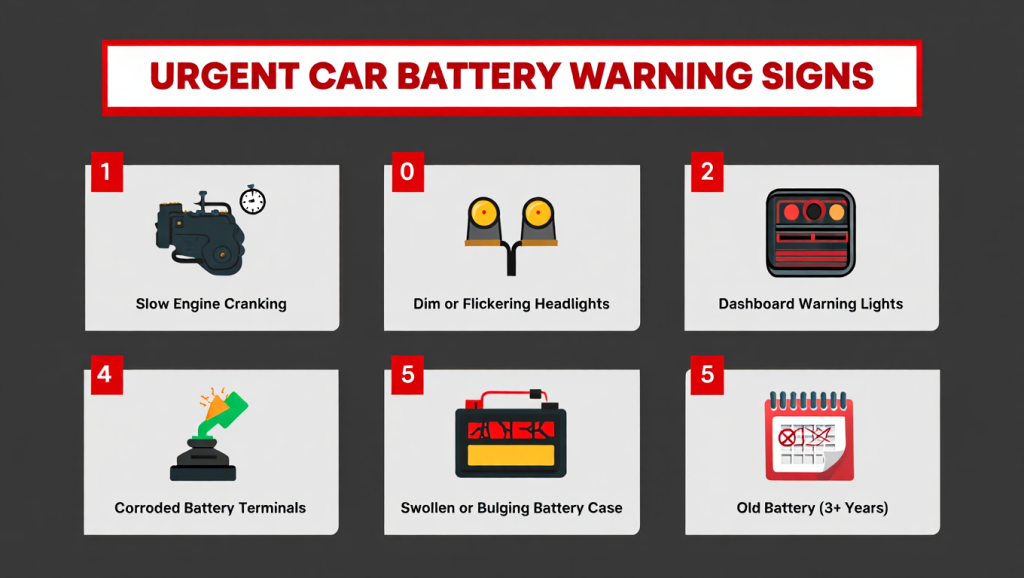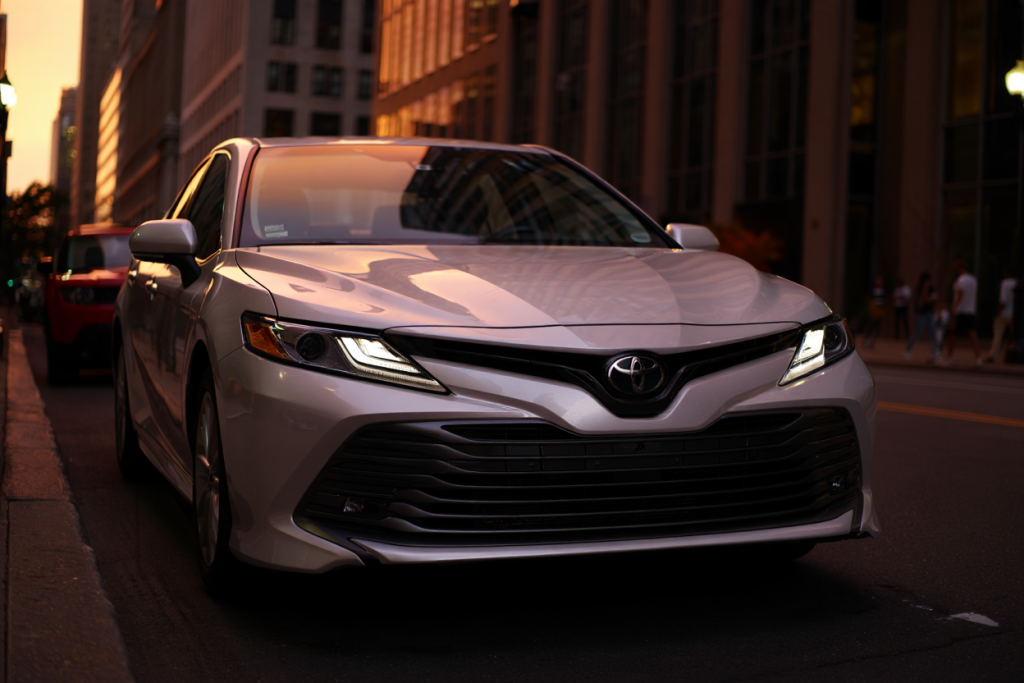When your car refuses to start on a cold morning or your headlights dim while idling, chances are your car battery is to blame. A weak or failing battery doesn’t just cause inconvenience—it can leave you stranded, damage electrical components, and cost you more in the long run. Knowing the signs of a failing car battery helps you act early, saving both money and stress.
In this article, I’ll cover the top 5 warning signs your car battery needs immediate replacement, explain the technical reasons behind them, break down replacement costs, and share real-world maintenance tips every driver should know.
Why Recognizing Battery Problems Early Matters?
Before diving into the signs, it’s worth understanding why battery health is so critical. A car battery isn’t just for starting your engine—it powers your ignition system, lights, electronics, infotainment, sensors, and safety features. When it starts to fail, your vehicle’s entire electrical system suffers.
Unlike other parts that give you months of warning, batteries can die suddenly. That’s why mechanics recommend watching for early warning symptoms and replacing the battery before it leaves you stranded.
Top 5 Signs Your Car Battery Needs Immediate Replacement
Here, let’s see some common signs to ensure your car battery needs immediate replacement–
Sign 1 – Slow Engine Crank
The most obvious red flag is when your car takes longer than usual to start. A healthy battery should provide strong cranking amps to spin the engine quickly.
Why It Happens
- As batteries age, their Cold Cranking Amps (CCA) drop, meaning they can’t deliver enough power to the starter motor.
- In cold weather, this problem becomes even worse as chemical reactions slow down.
Real-World Example
If your car usually starts within one second but now takes 3–5 seconds with a sluggish, dragging sound, your battery is on its last legs. Many drivers mistake this for a starter motor problem, but 8 out of 10 times, the battery is the real culprit.
Cost & Fix
- OEM battery replacement cost: $150–$300 depending on the vehicle.
- Aftermarket options: $70–$150 (flooded lead-acid), $180–$300 (AGM).
- Always match the correct group size and CCA rating to your car’s requirements.
H2: Sign 2 – Dim or Flickering Lights
Your headlights and interior lights rely directly on battery voltage. If they appear dimmer than usual or flicker when idling, it’s a strong indicator your battery is weak.
Why It Happens
- A failing battery can’t maintain a stable 12.6–12.8 volts when the car is off.
- Voltage drop causes lights, dashboard displays, and electronics to weaken.
- In hybrid and modern cars with high electrical loads, a weak battery triggers warning lights on the dash.
Practical Tips
- Use a multimeter to check voltage:
- 12.6V = fully charged
- 12.2V = 50% charged
- Below 12.0V = failing battery
- 12.6V = fully charged
- Mechanics often load-test the battery to confirm internal capacity.
OEM vs Aftermarket Comparison
OEM batteries usually provide more consistent voltage stability. Aftermarket can work fine, but cheap options often suffer from faster voltage drop under load.
Sign 3 – Frequent Jump Starts Needed
If you find yourself reaching for jumper cables more than once in a few weeks, your battery isn’t holding a charge anymore.
Why It Happens
- Sulfation (sulfate crystals build up on plates) reduces charging capacity.
- Heat damage evaporates electrolyte, leaving cells dry.
- Repeated deep discharges shorten lifespan drastically.
Real-World Scenario
A driver who leaves their headlights on overnight may kill even a new battery. But if the same car needs jump starts every other day, the issue is not user error—it’s a dying battery.
Cost-Saving Tip
Instead of carrying jumper cables around, replace the battery. Repeated jump starts stress your alternator and starter motor, leading to $400+ repairs later.
Sign 4 – Swollen Battery Case or Corrosion
A car battery is designed to be compact and sealed. If you notice swelling, bloating, or heavy corrosion on the terminals, it’s a sure sign of internal damage.
Why It Happens
- Heat exposure causes the case to expand.
- Overcharging (faulty alternator or cheap charger) builds up excess gas.
- Leaking acid leads to corrosion, reducing connection strength.
Symptoms to Watch
- White or bluish powder around battery terminals.
- Warped or bulging battery casing.
- Strong rotten egg smell (sulfur gas leak).
Replacement Advice
A swollen or leaking battery is a safety hazard. Replace it immediately. AGM batteries are more resistant to swelling compared to conventional lead-acid, making them a better long-term investment in hot climates.
Sign 5 – Battery Warning Light On Dashboard
Modern vehicles are equipped with a battery/charging system warning light. If it glows, don’t ignore it—it’s your car’s way of telling you something is wrong.
Why It Happens
- The alternator isn’t charging the battery properly.
- Loose or corroded cables prevent voltage flow.
- The battery itself has lost capacity and can’t hold charge.
Real-World Example
If your dashboard shows a battery light while driving at night, your car is likely running off stored battery energy alone. Within minutes, headlights, power steering, and even brakes could fail.
Cost to Diagnose & Replace
- Diagnostic test: $30–$50.
- New battery: $100–$300.
- If alternator is the issue: $400–$800 repair.
Common Mistakes Drivers Make With Weak Batteries

Even after noticing the signs, many drivers make mistakes that shorten battery life further.
Common Mistakes
- Ignoring OEM recommendations and buying the cheapest option.
- Installing the wrong group size or CCA rating.
- Not cleaning corroded terminals, leading to weak connections.
- Assuming a new battery can’t fail—defective batteries do exist.
- Storing cars for weeks in hot/cold weather without a battery maintainer.
Practical Tips to Extend Car Battery Life
Replacing a battery isn’t always cheap, but with proper care, you can maximize its lifespan.
Tips for Longer Life
- Regular Testing: Check voltage twice a year.
- Clean Terminals: Prevent corrosion with baking soda or terminal protectors.
- Avoid Short Trips: Repeated short drives prevent full recharging.
- Use a Trickle Charger: Great for stored cars or seasonal vehicles.
- Choose Wisely: AGM batteries cost more but last longer in harsh climates.
Cost Breakdown – Battery Replacement
Costs vary depending on the type of battery, your vehicle, and climate. Here’s a breakdown:
| Battery Type | Average Cost | Lifespan (Years) | Best For |
| Lead-Acid (Flooded) | $70–$150 | 3–4 | Older cars, budget buyers |
| AGM (Absorbent Glass Mat) | $180–$300 | 5–7 | Modern cars, start-stop systems, hot/cold climates |
| OEM Premium Batteries | $250–$400 | 5–7 | Luxury vehicles, electronics-heavy cars |
Long-term value tip: A $250 AGM battery lasting 6 years is often cheaper per year than replacing a $100 lead-acid every 3 years.
Conclusion
Your car battery is the heart of your vehicle’s electrical system, and it rarely fails without warning. If you notice slow cranking, dim lights, frequent jump starts, swelling, or a warning light, it’s time to act fast.
Replacing your battery before it dies completely saves you from breakdowns, towing fees, and costly alternator damage. Whether you choose an affordable lead-acid or a long-lasting AGM, make sure it matches your vehicle’s OEM specs.
FAQs
1. Why does my battery die more often in winter than summer?
Cold weather slows down chemical reactions inside your car battery, reducing cranking power by up to 50%. Oil also thickens, making the engine harder to turn. If your battery is weak, winter will reveal the problem faster than summer.
2. Is hot or cold weather worse for a car battery?
Both extremes are harmful. Heat evaporates electrolyte fluid, shortening battery life. Cold reduces cranking power and makes starting harder. Statistically, heat kills more batteries long-term, while cold exposes weak ones. That’s why batteries often fail at the first cold snap.
3. Should I buy a different battery type depending on my climate?
Yes. In hot climates, AGM batteries resist heat and swelling better. In cold climates, choose a battery with high Cold Cranking Amps (CCA) for reliable starts. Always check your owner’s manual for OEM recommendations to ensure proper fit and performance.
4. How can I tell if my battery is heat-damaged?
Signs of heat damage include a swollen case, low electrolyte levels, corrosion on terminals, and a sulfur smell. If your battery struggles to hold charge after hot weather, it’s best to test it with a load tester or replace it immediately for safety.
5. Do AGM batteries last longer in extreme weather?
Yes. AGM batteries are sealed, spill-proof, and more resistant to vibration, heat, and cold compared to traditional lead-acid. They recharge faster, last longer in harsh climates, and require no maintenance, making them worth the higher upfront cost for many drivers.
6. How often should I test my battery in harsh climates?
Ideally, test your car battery twice a year—once before summer and once before winter. In very hot or cold regions, quarterly testing is even better. Many auto parts stores and repair shops offer free battery testing to ensure you don’t get stranded.

Benjamin Grey is an automotive engineer and writer at Car Parts Advisor. With years of experience in the automotive industry, he shares expert advice on car parts, maintenance, and repairs to help car owners keep their vehicles running smoothly.





